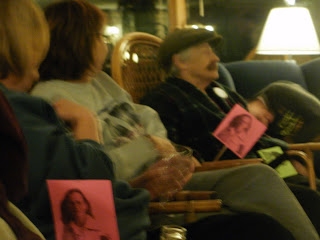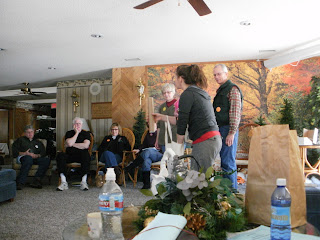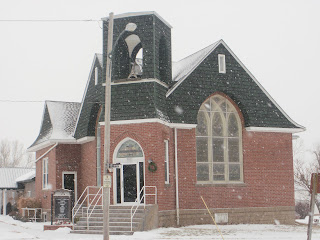The Settlement of Kansas: Railroad Hype Drew Settlers
BY FRED MANN
The Wichita Eagle
Sunday, January 23, 2011
reprinted from http://www.kansas.com/2011/01/23/1686997/the-settlement-of-kansas.html#
To hear the railroads tell it, Kansas was the Garden of Eden. "Temperate Climate, Excellent Health, Pure & Abundant Water," the Atchison, Topeka & Santa Fe Railroad declared on an advertising flier in 1876.
The "best stock country in the world," the Kansas Pacific Railway boasted in 1878.
The state was more productive than most, according to an 1870 handbook printed by the Kansas Pacific. Its crops yielded more profit because they were cheaper to raise. Its weather allowed farmers to do more work.
Kansas, the handbook said, offered "unsurpassed grazing" and an "enterprising population."
The climate, it said in a statement that would be proven wrong more than once in the state's early decades, "is mild and pleasant."
The hype worked.
People came to Kansas from around the world in the 1870s, after the Civil War and "Bleeding Kansas" days had ended.
In large part, the new immigrants made the prairie into productive farmland and shaped our future.
They farmed the land and founded towns, and they passed their pioneer hardiness and work ethic to future generations of Kansans.
They came from Croatia, Germany, Russia, Sweden, Denmark, England, France.
They came from Pennsylvania, West Virginia, Kentucky, Missouri, Ohio, Illinois, New York.
Ethnic groups from foreign lands formed colonies all over the state, retaining their languages, customs and cultures and passing them on.
They came for land and opportunity, and also to escape religious persecution, poverty and compulsory military service in their home countries.
"From the beginning we're being shaped by people of different backgrounds, particularly parts of Europe, but also African Americans and Native Americans," said Virgil Dean, editor of Kansas History: A Journal of the Central Plains and publications director for the Kansas Historical Society.
"It's kind of symbolic of the story of America."
Railroad Promotions
The railroads, trying to sell the millions of acres given to them by the U.S. government to grow their business, promoted Kansas all over Europe and Russia and the rest of the American states.
"The railroads were highly privileged, and the Supreme Court supported them lock, stock and barrel," said Robert Linder, history professor at Kansas State University. "They were able to make fortunes off settling the Great Plains."
Railroads offered free or reduced-rate transportation to Kansas, and settlers from overseas could bring all of their household goods at a railroad's expense.
It wasn't always a pleasant way to travel. The authors of an 1859 handbook offering advice to prospective settlers of the Kansas and Rocky Mountain territories cautioned that they "will probably have to put up with a sleeping cot in the saloon — a style of nocturnal accommodation which is exceedingly uncomfortable to persons unaccustomed to Western travel."
The restaurants on the trains were run by "very avaricious and inhospitable persons" out to swindle diners, they wrote.
"Frequently, too , the food is filthy, bread badly baked and unwholesome; the tea and coffee cold, or so bitter and black that they are far from furnishing an agreeable repast," they wrote.
And yet, people came. In 1860, a year before Kansas became a state, its population was 107,000. By 1875, it had grown to more than half a million.
Germans were the largest group of foreign immigrants to Kansas. Some came from Germany, but many came from the Volga River in southern Russia, where they excelled in agriculture and were drawn to Kansas by railroad posters.
But before the Volga Germans came, they sent five scouts to investigate. They were wary about the new territory after what had happened to them in Russia.
They had left their native Germany on promises from Catherine the Great of exemption from military service, freedom from taxation and free land. These privileges had slowly disappeared.
One of the scouts was Anton Wasinger, great grandfather of Leona W. Pfeifer of Hays. He and four other men came to America in 1874 to look at the territory and returned to Russia with some soil samples and a favorable report.
The land reminded them of the Volga.
A year later, groups of Volga German colonists came over by ship, then traveled by train to Topeka, where they spent the winter before moving west and starting villages in Ellis and Rush counties, each with its own dialect.
"They were a hard-working people, very reliable," said Pfeifer, who speaks with a trace of a German accent.
Self-reliance was important to them. They were ridiculed in newspapers for their dress, speech and customs, Pfeifer said, so they developed a mistrust of outsiders.
"They didn't get any help from anybody, so they had to take care of themselves," Pfeifer said.
Hard work was the family ethic.
"They worked from early morning to late at night. That's what made Ellis County," said Pfeifer, a former history and German teacher.
Hardy Settlers
Most early Kansas settlers had lived in states farther east before making a final push west.
In 1871 Jesse Tyler Sturm of Shinnston, W.Va., traveled to Kansas by train with a brother-in-law looking for land to homestead.
As a Civil War veteran on the Union side, he was entitled to 160 acres of free land from the U.S. government, although it could have been railroad land they were after as well, said Karen Sturm, wife of Jesse Sturm's great-grandson, Harold, of Caldwell.
After failing to find any land that hadn't been claimed, they planned to return to West Virginia. But when a stage coach they were awaiting arrived, a passenger told them about great land in the southern part of Kansas that hadn't been taken.
The men traveled by covered wagon to the Oklahoma line, seeing Indians and buffalo but no trees, Karen Sturm said.
Jesse Sturm staked a claim northeast of Caldwell in spring 1872 and brought his wife and four children to Kansas.
They lived out of covered wagons the first year. They had to travel 80 miles to Newton to buy processed lumber to build a house, Karen Sturm said.
"That was the way life was. It was hard and they didn't think anything about it," she said. "They were so hardy, our ancestors. They had to be."
Jesse Sturm was a gifted storyteller. In 2002 the state of West Virginia published his Civil War book, "From a Whirlpool of Death ... to Victory," remembrances of his service with the 14th West Virginia Infantry.
Sturm became a justice of the peace, and township trustee and assessor.
He was Sumner County treasurer and trustee of Sumner County high schools, and was appointed by the governor as a member of the River and Harbor Congress and a delegate to the inter-state wheat congress.
An active Republican, he was urged to run for the state Senate in 1918 but declined because of failing health.
His great-great-grandson, Ryan Sturm, is the fifth generation to farm in Sumner County.
His farm is five miles from Jesse Sturm's original homestead.
Haven For Ex-Slaves
Kansas, where anti-slavery forces had prevailed in its "Bleeding Kansas" days, became a haven for former slaves.
W.R. Hill, a white land speculator in Nicodemus in Graham County, traveled through the South to sell the state to African Americans still burdened by Jim Crow laws.
He promised that they could own their own land, build their own town and govern themselves.
Angela Bates' family was among the first group of 350 to make the five-day trip from Kentucky by train in 1877.
Most of them had never been on a train.
And they didn't like what they saw when they crossed the Flint Hills into Graham County — barren terrain where the few residents of Nicodemus lived in earthen dugouts.
"There was nothing except a few holes in the ground," Bates said.
About 60 returned to Kentucky.
More came as part of the exodus of former slaves from the South, but it took strong spiritual resolve to remain, Bates said.
Those who did built the town rapidly in the 1880s, replacing the dugouts with successful stores and businesses.
Bates, who worked to get Nicodemus designated as a national historic site, said the town "represents us and what we did with freedom. It became the icon of our ability to self-govern and make it on our own.
"These people had tenacity," she said. "They took freedom and did something with it."
Nicodemus failed to attract railroad lines in the late 1880s, and its economy declined. Many residents, including Bates' parents, were forced to leave.
But they took the spiritual values and work ethic of their Nicodemus heritage with them and were able to get middle- to upper-class jobs, she said.
Bates said she sees a difference between African-Americans descended from the people who ventured to Kansas and those from families that remained in the South.
"There's a lot of complacency there," she said. "They conform to that environment because that's where slavery took place."
Kansas African-Americans are resourceful, Bates said.
Many of those who left Kansas had sense enough to come back and make Nicodemus their home again.
That includes her father, James Bates, 83, who still farms a mile north of Nicodemus.
Building Towns
While many came to Kansas to farm the land, others came to build the towns that served the farmers.
It's a misconception that Kansas was just a farm settlement, said Dean, of the state historical society.
"A big majority came for farming, but a few miles away there's going to be a town starting at the same time."
Arriving trains unloaded merchants, bankers, blacksmiths, painters, gunsmiths, bricklayers, shoemakers, tailors and peddlers.
And stonemasons, like Franklin Rothenberger, whose family would build much of Osborne and the surrounding area.
Rothenberger was 9 when he came to Kansas by rail as part of the "Pennsylvania Colony" that founded Osborne in 1871.
On the wagon train taking them on the final leg of the trip, the tallgrass was so high they couldn't see where they were going, said Von Rothenberger, Franklin's great-grandson.
Somebody who left the group for supplies couldn't find the party when he returned and had to ask for help.
Franklin Rothenberger eventually was designated a stone and brick mason by the colony because that had been the family's business back in Pennsylvania.
He was trained by fellow homesteading stonemasons and in 1884 started the Rothenberger Construction Company.
Franklin and his five sons quarried and laid the stone for St. Joseph's Church in Damar, a finalist for the Eight Wonders of Kansas Architecture. At the same time, he bicycled to other towns in the region to oversee other construction projects.
 |
Franklin Antone Rothenberger was nine years old when the town of Osborne City, Kansas was founded on May 1, 1871. |
 |
The Rothenberger Construction Company laying down the first brick sidewalks in downtown Osborne, Kansas in 1908. Here Frank Rothenberger (center) is directing his brother Peter (left). |
 |
One of the numerous jobs that the Rothenberger Construction Company did over the years. The number of jobs completed in the 95 years of the company's history is believed to be around 15,000. |
By then, Von Rothenberger said, the family had built foundations, churches, homes, buildings, even sidewalks and curbs, across western Kansas from Syracuse to Medicine Lodge to Salina.
What Franklin gave to his family was the satisfaction of seeing a job done, Von Rothenberger said. "He instilled a work ethic into the family and into the business."
Laughable Conditions
Those who settled Kansas occasionally may have found conditions as agreeable as the railroads had advertised.
But they also faced drought, harsh winters and summers, jackrabbit attacks, grasshopper infestations, dust storms, financial downturns, and dwindling populations.
In the 1890s, the railroads stopped advertising Kansas.
"People laughed at the railroad enthusiasms that once so gripped them," the late Wichita State University history professor Craig Miner wrote in "West of Wichita: Settling the High Plains of Kansas, 1865-1890".
A Mitchell County schoolteacher wrote in her diary in 1881:
"This is a hard place to live, this Kansas is. I wonder what in the world will become of us, anyway?"















































































